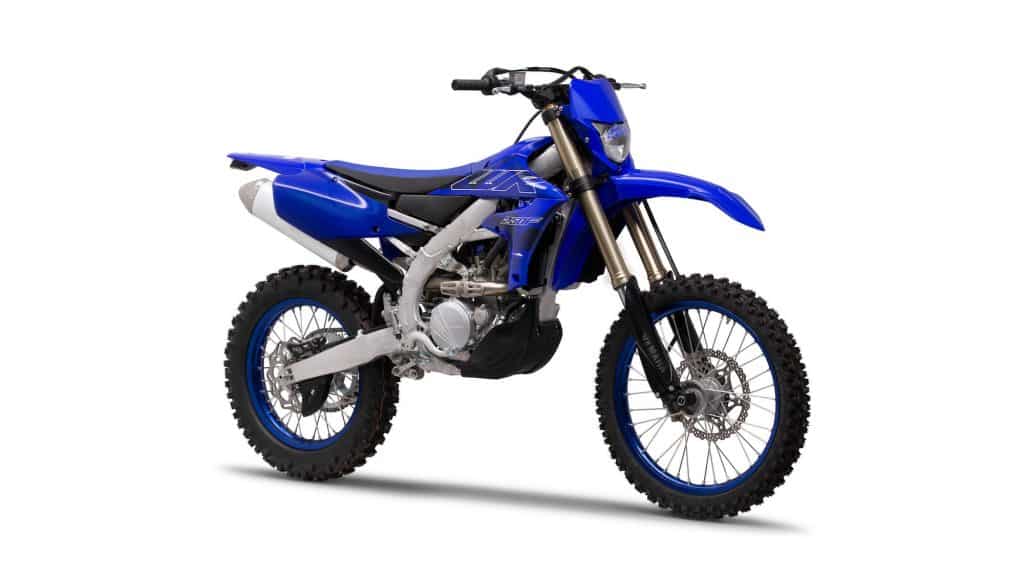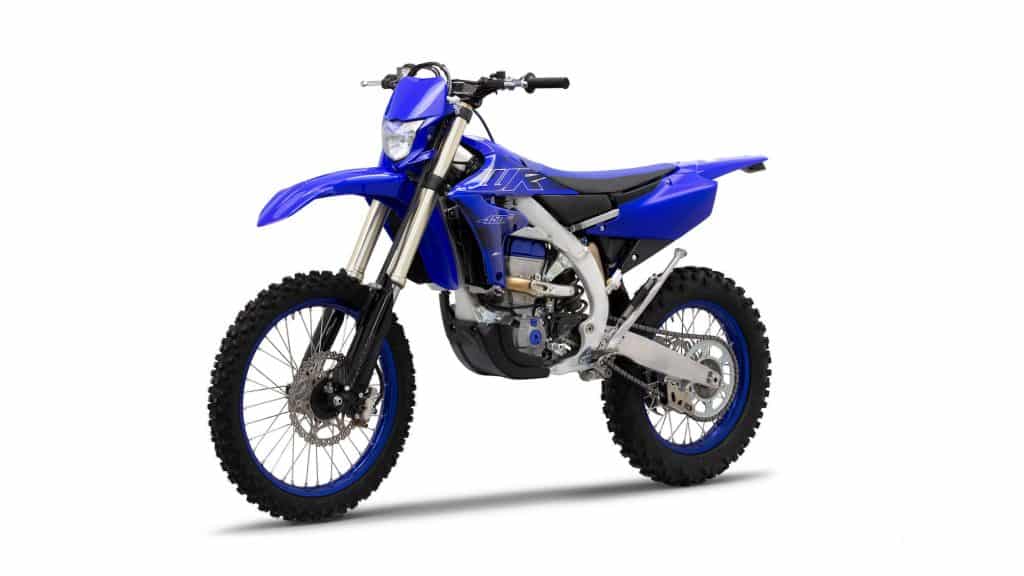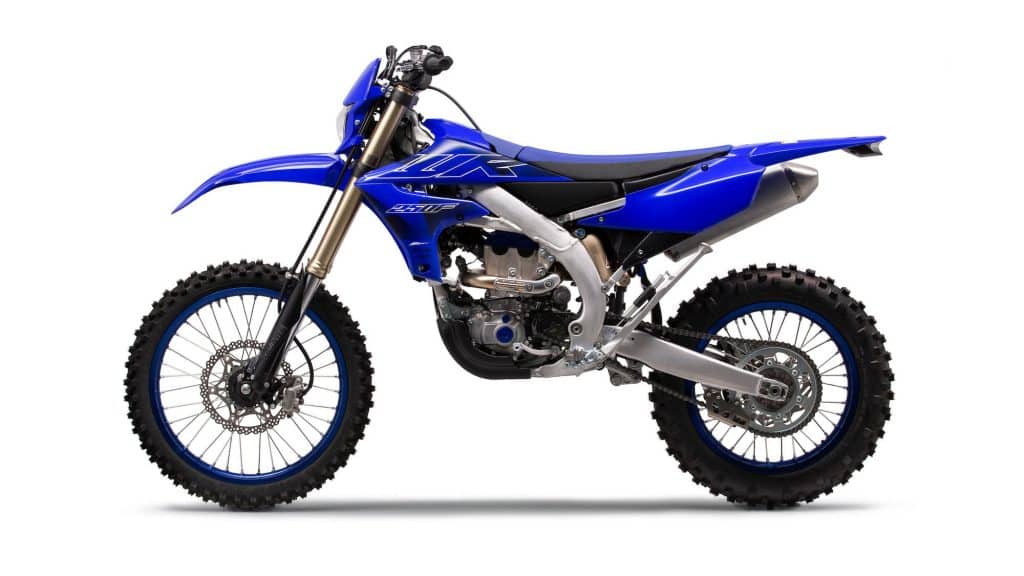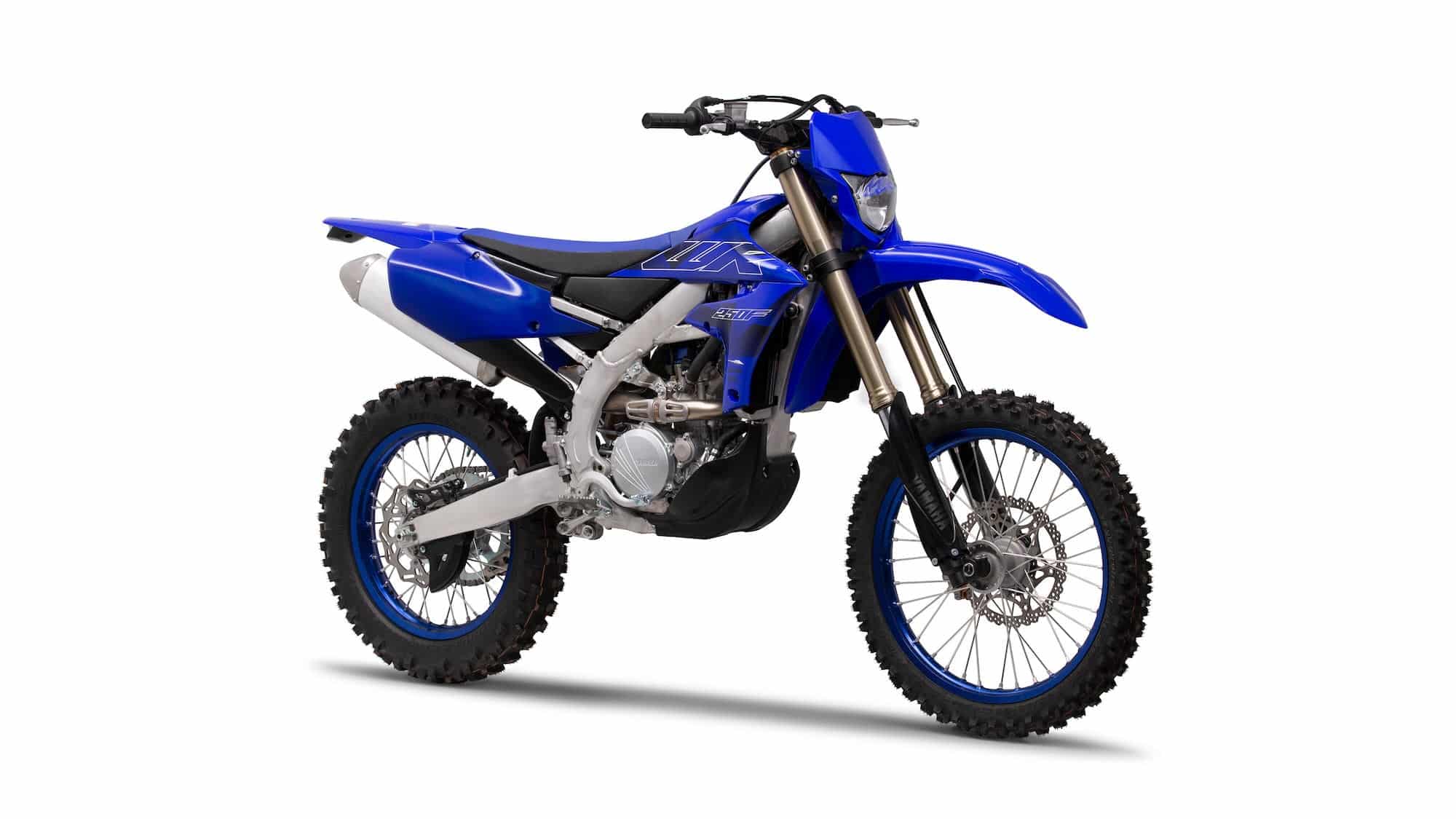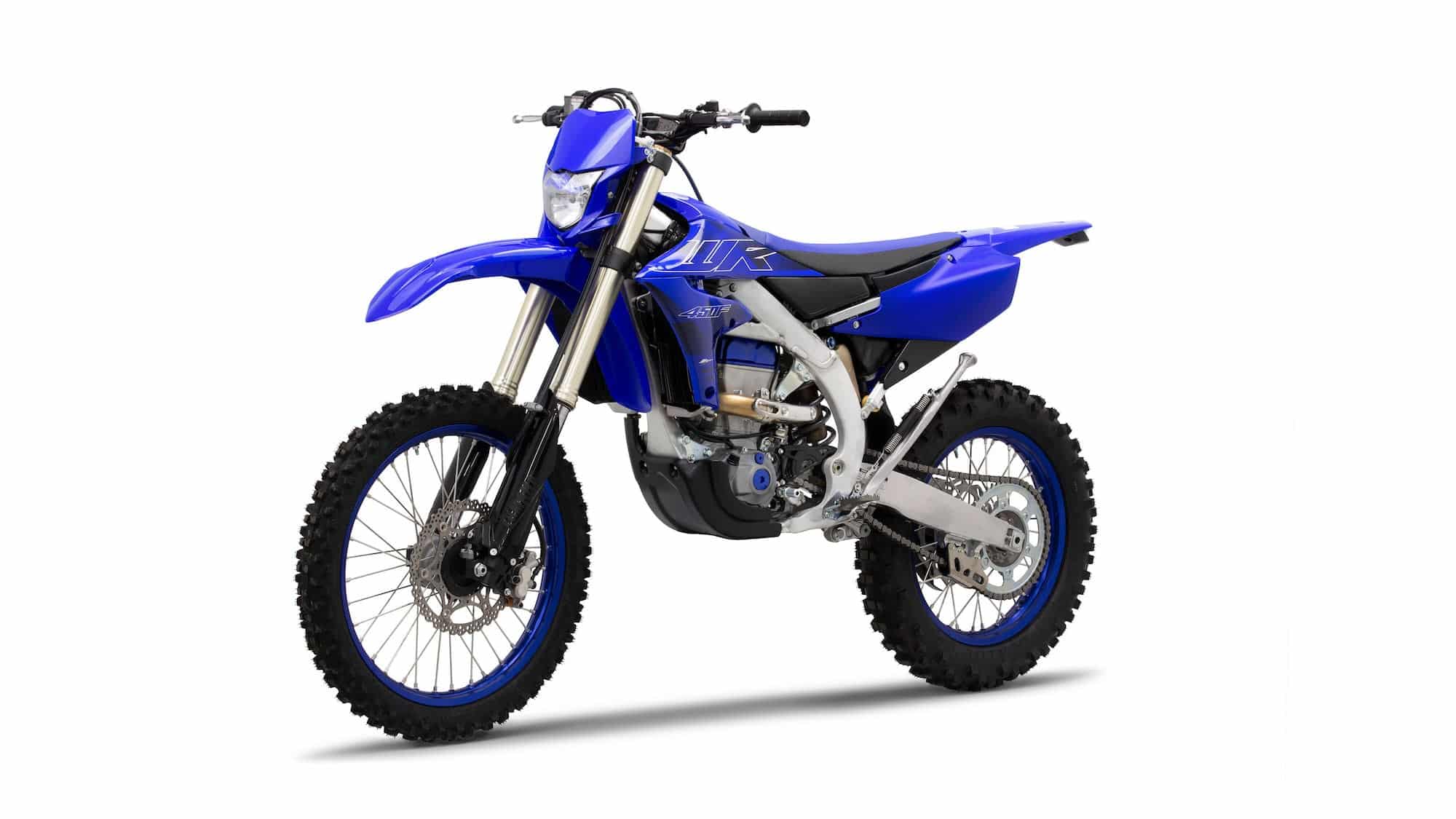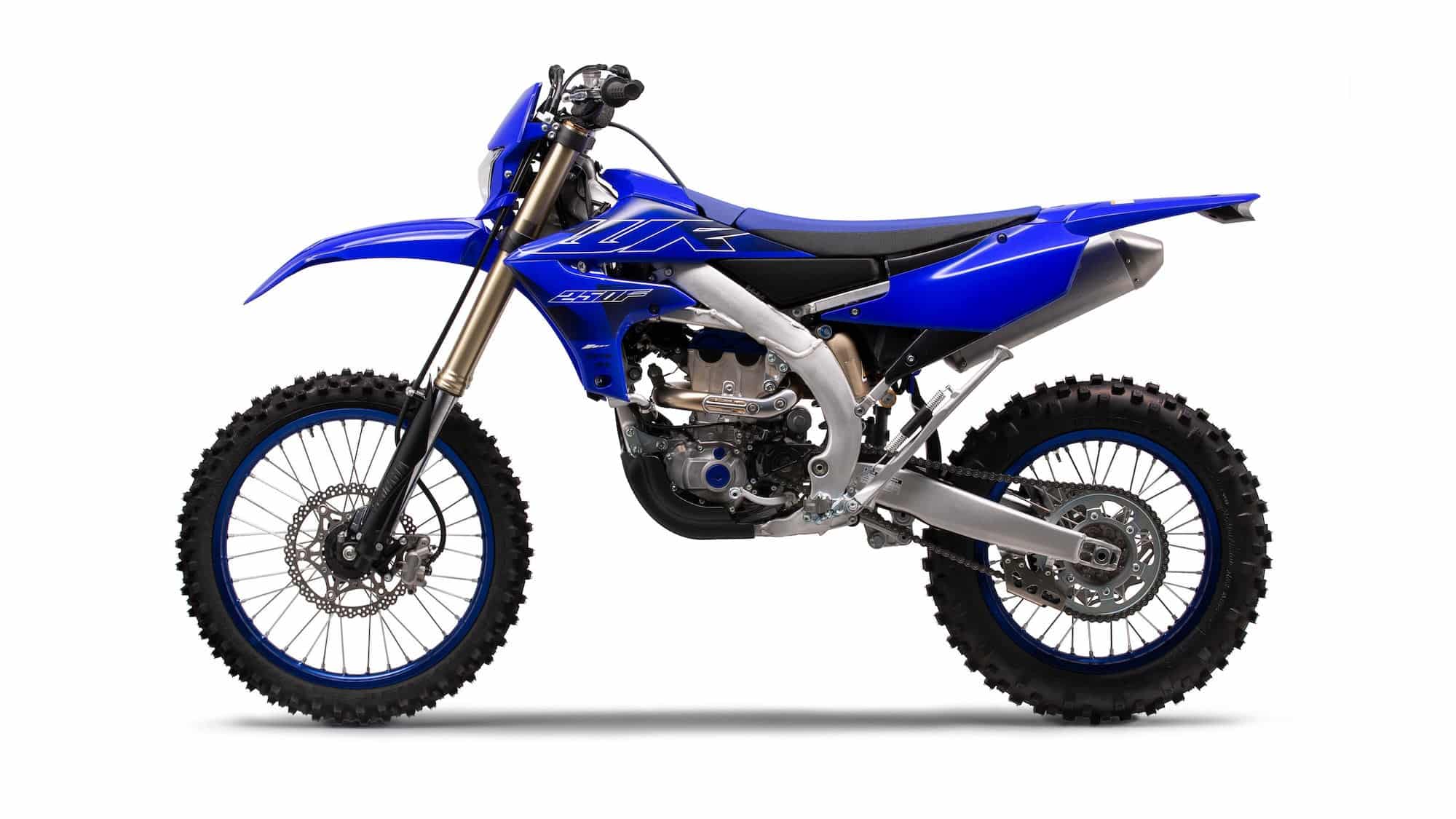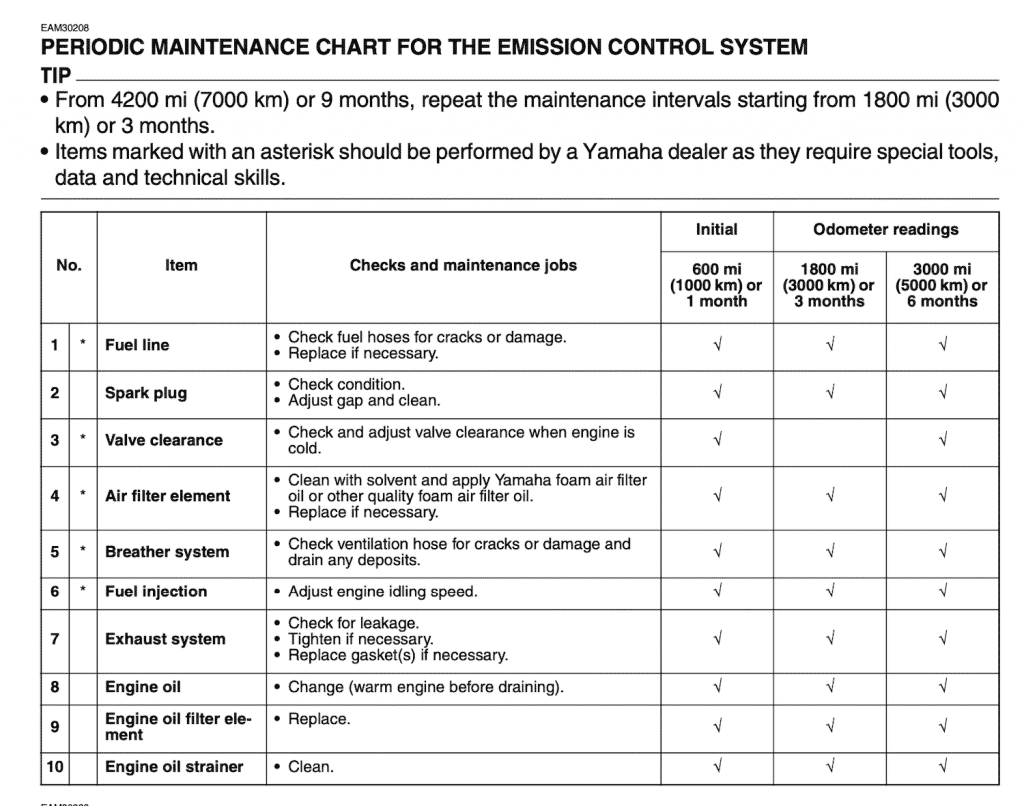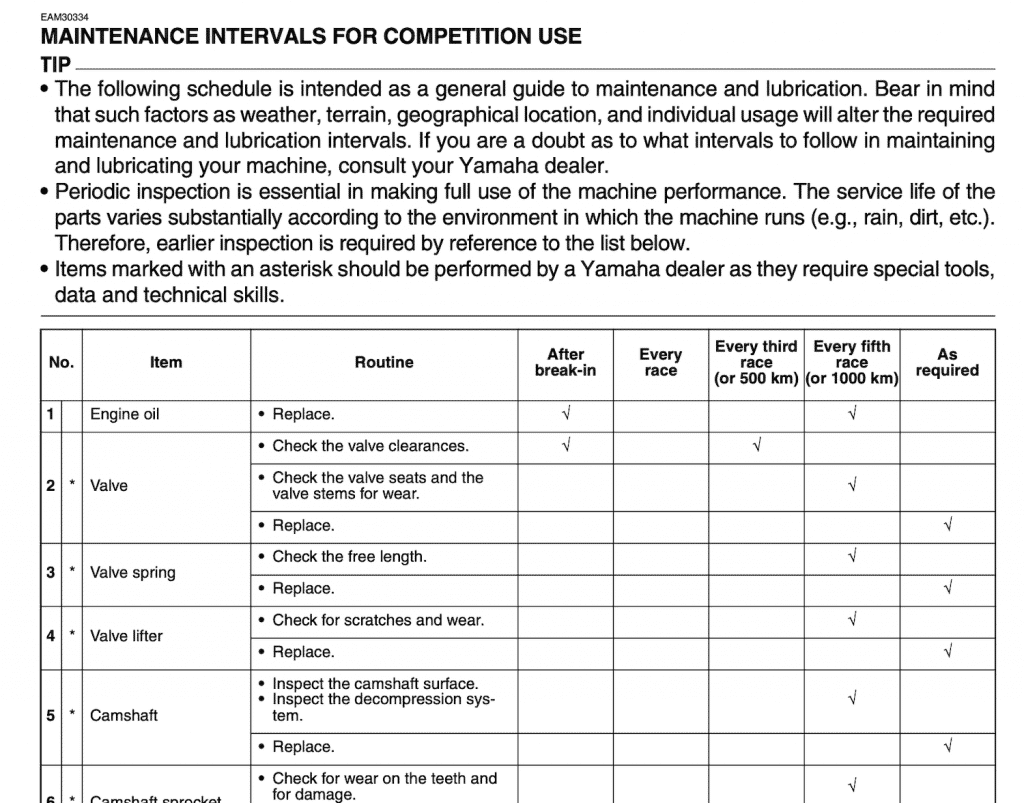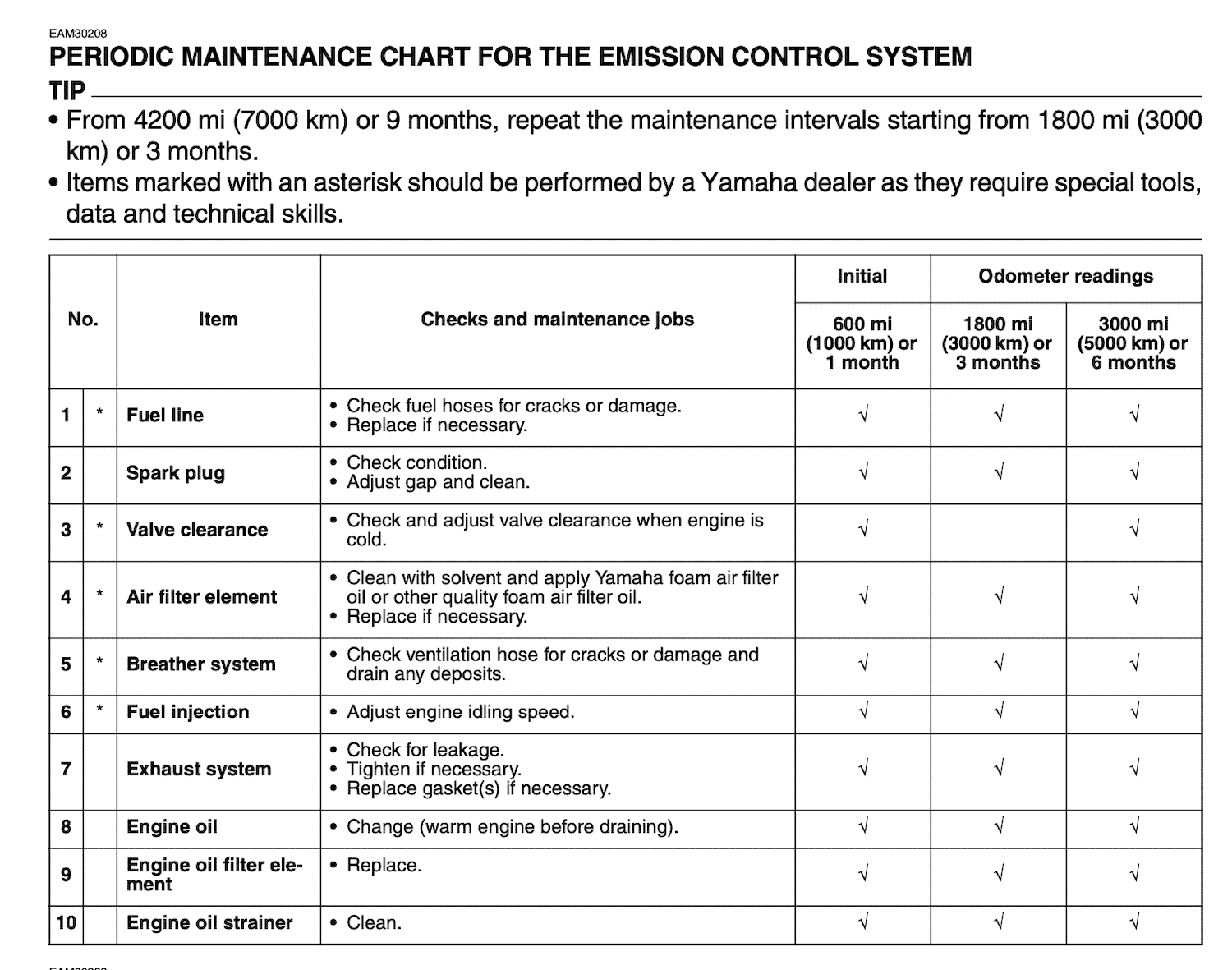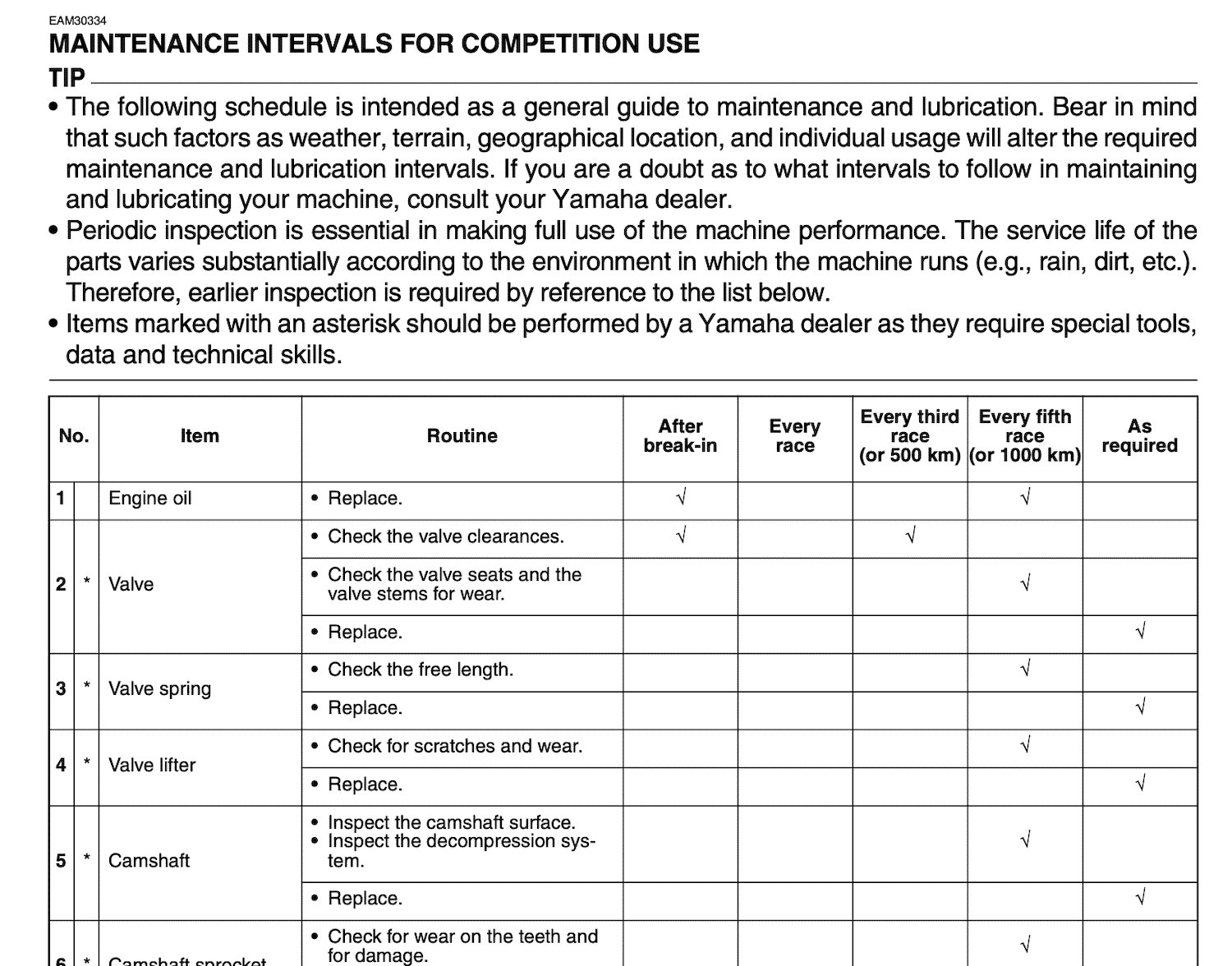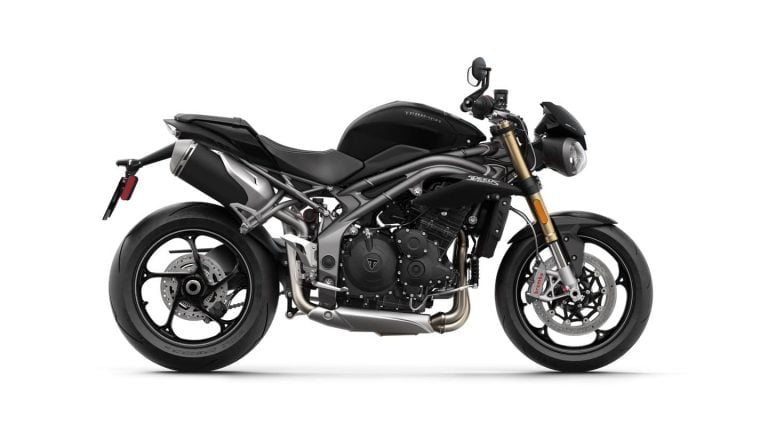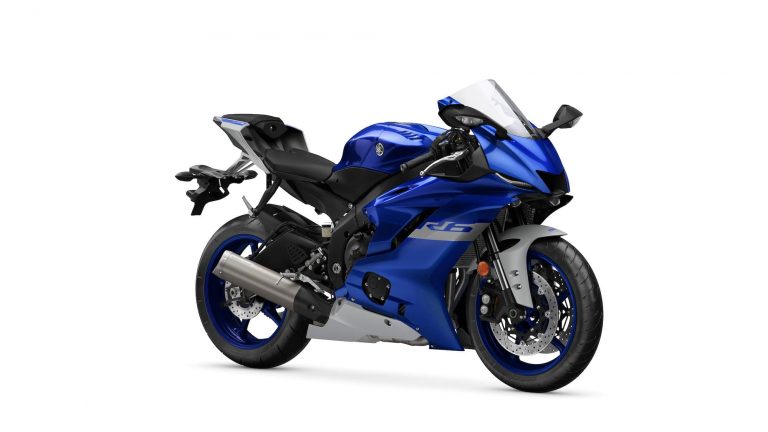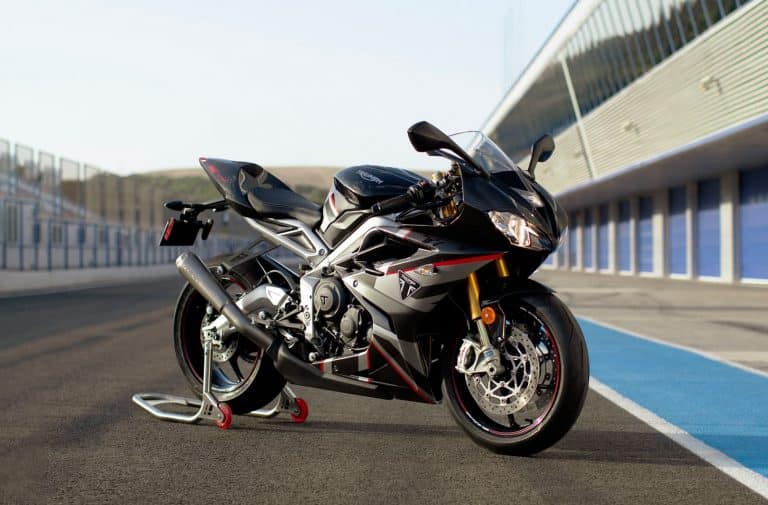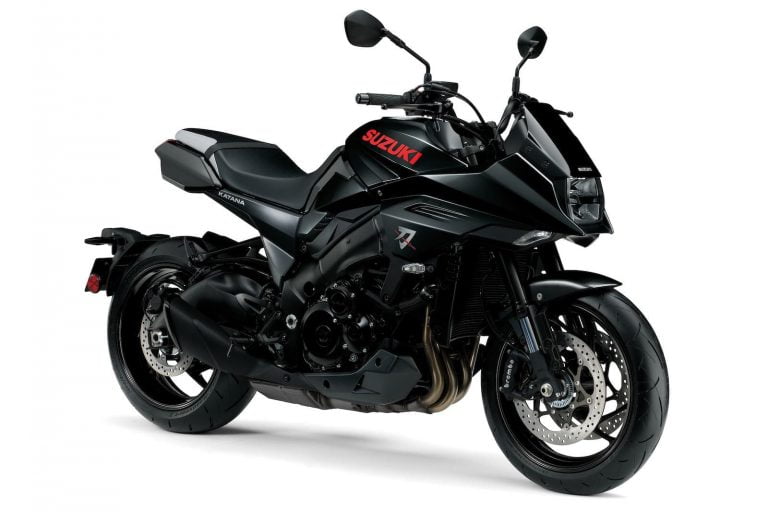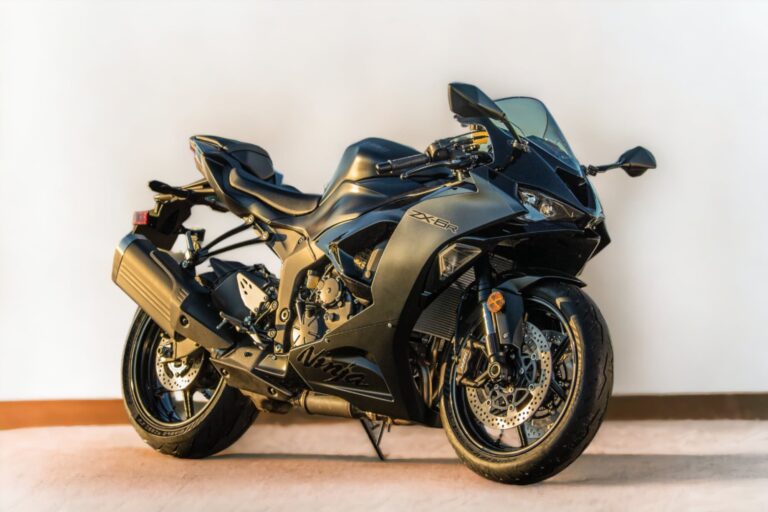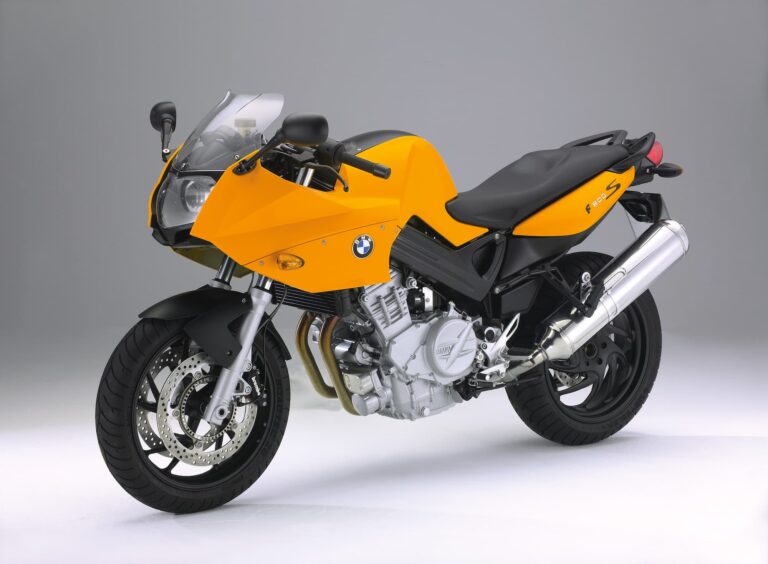Yamaha WR450F (Fuel Injected) Maintenance Schedule and Service Intervals
This is the maintenance schedule and service intervals for the fuel-injected Yamaha WR450F, a street-legal enduro bike that people sometimes convert into supermoto bikes.
The Yamaha WR450F is an enduro bike that’s based on the YZ450F. It’s available in street-legal form (with mirrors, lights etc.) but those are frequently removed.
It succeeded the earlier WR400F and WR426F, which were carburettor-fed more enduro-focussed offerings, with kick starters only.
Since launch in 2003, the WR450F has always been based around a single-cylinder 449cc DOHC liquid-cooled “thumper” engine. It has an electric starter and street gear.
But the WR450F has gone through a few generational changes. Here they are in a nutshell:
- 2003-2006: The original WR450F, first in the WR line with an electric start (and also a kick-starter with a handle-bar mounted decompressor). Steel-framed. Very modified engine compared to the earlier WRs with lightweight pistons, valves, springs, etc. A 5-valve design.
- 2007-2011: Lighter aluminium frame, revised tuning, new air cleaner, wave brake rotors, and other new components.
- 2012-2015: First fuel-injected WR450F, using the old engine but with added fuel injection. Slim frame borrowed from the YZ450F. Rear brake is now wave-type too.
- 2016-2019: Second version of the fuel-injected WR450F, with a motor now borrowed from the YZ450F, bringing them closer together — a higher-performance 4-valve fuel-injected motor with a reverse slant.
- 2020+: New, higher higher performance motor. The WR450F and YZ450F are very similar now, other than the WR450F having a wider-ratio gearbox and running gear to be road registered.
The maintenance schedule is quite similar between the years, but there are some different line items, and different maintenance parts.
This post was originally published July 18, 2021, but has since been significantly updated.
This site has links for things like oil and spark plugs from which we earn a commission (which unfortunately nobody can save, not even us). If you appreciate this work, then please use those links. Thanks!
Yamaha WR450F Service Intervals
Overall, the fuel-injected WR450F has service intervals of 1800 miles / 3000 km or three months for oil changes, with valve services required every 3000 miles / 5000 km, or two services (rounded slightly). Replace the oil filter at the same time.
Check the spark plug at every service, and adjust it and clean it. Just replace it as necessary.
The WR450F is an offroad-oriented bike, so make sure you keep it clean, with the chain lubricated and the parts that are susceptible to corrosion as free of moisture as possible.
What you need to service your Yamaha WR450F
Below are the parts needed to do a basic service on the Yamaha WR450F.
| Part | Yamaha WR450F spec |
|---|---|
| Engine oil | Yamalube 10W-40 or Yamalube 10W-50. Can also use 15W-40, 20W-40, or 20W-50. Oil must be API service SG or higher, JASo standard MA. You need just 0.64L of oil. |
| Oil filter | All WR450F models share the same oil filter, part 5d3-13440-09-00, or the HifloFiltro equivalent HF141. |
| Spark plug | NGK CPR8EA-9 type spark plug with an 0.8-0.9mm gap. This is different to other year models. |
| Coolant | Use ethylene glycol-based coolant only. |
| Air filter | Part for the 2020+ WR450F is B3J1445111. K&N equivalent part is YA-4518XD. |
| Brake pads | Brake pads for the 2020+ WR450F are the same as the 2016-2019 ones. Yamaha part numbers are B292580500 and 1C3W0046B0. For the rear pads you can use EBC brake pads FA185R. |
| Lubricating grease | Use lithium soap-based grease for external lubrication. |
| Cables | Lubricate cables with Protect All Cable Life. |
Maintenance schedule for the Yamaha WR450F
Below is the full maintenance schedule for the Yamaha WR450F. It’s from the manual, though simplified somewhat.
Notes on the maintenance schedule
- Minor service is every 2,000 km (1,200 mi) or 3 months.
- Major service is every second minor service and includes the minor service plus checking the valve clearance and cleaning the spark arrester
- After the end of the schedule, keep going, alternating between major and minor service.
Notes:
- Yamaha manuals recommend you just do basic lubrication (changing the oil, lubing the chain). But of course most WR owners will do their own maintenance.
- (1) — Previous manuals said to replace brake hoses every 20,000 km or 2 years.
| mi x 1000 | 0.6 | 1.8 | 3 | |
|---|---|---|---|---|
| km x 1000 | 1 | 3 | 5 | |
| months | 1 | 3 | 6 | Every |
| Change engine oil (Yamalube 10W-50) while engine is warm | ✓ | ✓ | ✓ | |
| Replace oil filter | ✓ | ✓ | ✓ | |
| Check spark plug condition. Adjust gap and clean | ✓ | ✓ | ✓ | |
| Check and adjust valve clearance when engine is cold | ✓ | ✓ | ||
| Clean air filter with solvent and apply foam air-filter oil equivalent oil. Replace if necessary. (Do not clean with compressed air.) | ✓ | ✓ | ✓ | More often when riding in dusty/wet areas. |
| Adjust EFI engine idling speed | ✓ | ✓ | ✓ | |
| Clean oil strainer | ✓ | ✓ | ✓ | |
| Check clutch operation. Adjust or replace cable. | ✓ | ✓ | ✓ | |
| Check cooling system hoses for cracks of damage. Replace if necessary | ✓ | ✓ | ✓ | |
| Replace coolant with ethylene glycol-based coolant | 1 year | |||
| Check front brake operation, fluid level, and for fluid leakage. Replace brake pads if necessary | ✓ | ✓ | ✓ | |
| Replace brake fluid (front) | 1 year | |||
| Check rear brake operation, fluid level, and for fluid leakage. Replace brake pads if necessary | ✓ | ✓ | ✓ | |
| Replace brake fluid (rear) | 1 year | |||
| Replace rubber parts of brake master cylinder and calipers | 1 year | |||
| Check brake hoses for cracks or damage | ✓ | ✓ | ||
| Replace brake hoses | 4 years | |||
| Lubricate brake and clutch levers with lithium soap-based grease lightly. | ✓ | ✓ | ✓ | |
| Lubricate brake pedal pivot shaft with lithium soap-based grease lightly. | ✓ | ✓ | ✓ | |
| Check side stand operation. Apply lithium soap-based grease lightly. | ✓ | ✓ | ✓ | |
| Lubricate rear suspension link pivot with molybdenum disulfide grease lightly | ✓ | ✓ | ||
| Lubricate control cables thoroughly (Protect all cable life) | ✓ | ✓ | ✓ | |
| Check throttle operation and free play. Adjust the throttle cable free play if necessary. Lubricate the throttle grip housing and cable. (Protect all cable life) | ✓ | ✓ | ✓ | |
| Check chain slack/alignment and condition. Adjust and lubricate chain (Motul chain paste) | Ride | |||
| Check swingarm bearing assemblies for looseness. Moderately repack with lithium soap-based grease | ✓ | ✓ | ✓ | |
| Check steering bearing assemblies for looseness. Moderately repack with lithium soap-based grease | ✓ | ✓ | ✓ | 2000 km (1200 mi) or 1 year |
| Check wheel runout, spokes tightness and for damage. Tighten spokes if necessary | ✓ | ✓ | ✓ | |
| Check tire tread depth and for damage. Replace if necessary. | ✓ | ✓ | ✓ | |
| Check wheel bearings for smooth operation. Replace if necessary. | ✓ | ✓ | ✓ | |
| Check front fork operation and for oil leakage. Replace if necessary. | ✓ | ✓ | ||
| Check shock absorber operation and for oil leakage. Replace if necessary. | ✓ | ✓ | ||
| Check fuel hoses for cracks or damage. Replace if necessary | ✓ | ✓ | ✓ | |
| Check crankcase ventilation hose for cracks or damage and drain any deposits | ✓ | ✓ | ✓ | |
| Check exhaust for leakage. Tighten fasteners if necessary. Replace gasket(s) if necessary | ✓ | ✓ | ✓ | |
| Clean spark arrester | ✓ | |||
| Check battery terminal for looseness and corrosion | ✓ | ✓ | ||
| Check all chassis fitting and fasteners. Tighten if necessary | ✓ | ✓ | ✓ |
Chain Maintenance
As a high-performance enduro bike (or supermoto), you need to regularly check the chain condition and tension, and adjust it or replace it as necessary. Yamaha recommends you check, clean, and adjust the chain every ride.
- Clean and lube the chain with a high-quality chain cleaner and lubricant like Motul chain lube.
- Check the condition of the chain by examining it for rust and wear, and checking the length of a segment of chain (at 15-link length should be maximum 239.3 mm or 9.42 inches). At the same time, check the sprockets.
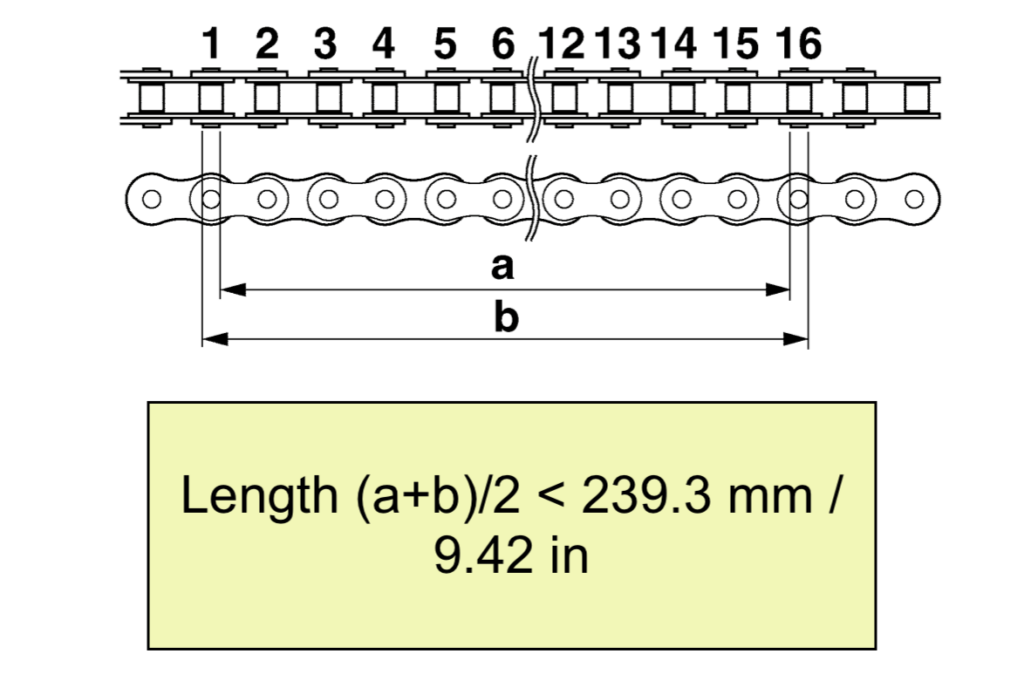
To check the slack on the WR450F, put the motorcycle in neutral, onto its kickstand or supported in some other way, and on a level surface.
Check the slack on the upper part of the chain, midway between the sprockets, and check it in multiple places (move the motorcycle forwards and backwards) as chains wear unevenly.
Pull upward on the chain above the drive chain guide installation bolt with a force of about 50 N / 37 lbf (about equal to a 5kg or 10lb weight, but upward). Chain slack on the WR450F is the distance between the bottom of the chain and the drive chain guide.

Target chain slack for the Yamaha WR450F: 50 – 60 mm (1.97 – 2.36 in)
If the chain slack is out of spec, you need to adjust it.
Adjusting chain slack
To adjust the chain slack on the Yamaha WR450F, follow the steps below. It’s much like adjusting slack on most motorcycles.
As with measuring chain slack, make sure that the motorcycle is on a level surface on its kickstand or other support, in neutral, with no weight on it (no saddlebags / luggage).
- Loosen the rear axle and the adjuster lock nuts on either side of the axle.
- Turn the adjusting bolts on both sides to tighten (or loosen) the chain. Keep checking the chain tension to see if it has come within spec.
- Keep an eye on the adjuster alignment marks on either side of the axle. Make sure that the adjustment is to the same point. Push the rear wheel forward to make sure there’s no clearance between the swingarm end plates and the ends of the swingarm
- When you’re done, tighten the axle to 125 Nm / 92 lb-ft.
- Tighten the drive chain puller locknut to 21 Nm / 15 lb-ft.
- Re-check the chain slack again to make sure it’s still within spec.
Tires and tire pressures for the Yamaha WR450F
Here are the recommended tire sizes and pressures for the Yamaha WR450F. Stock, it comes shod with tubed Metzeler MCE Six Days Extreme tyres, or Dunlop MX3S in Canada.
Of course, these are suggested per the manual and are optimised for life. But owners will adjust based on ride style, weight, and trail conditions.
| Wheel | Tire size | Tire pressure |
|---|---|---|
| Front | 90/90-21 54M M+S* | 100 kPa (1 bar, 15 psi) |
| Rear | 130/90-18 69M M+S* | 100 kPa (1 bar, 15 psi) |
* Canada has a different standard tyre that’s 80/100-21 51M up front, and 120/90-18 65M at the rear.
Note: “Tire” is US spelling and “Tyre” is rest-of-world spelling. But pressures are given in all units.
About the 2020+ Yamaha WR450F
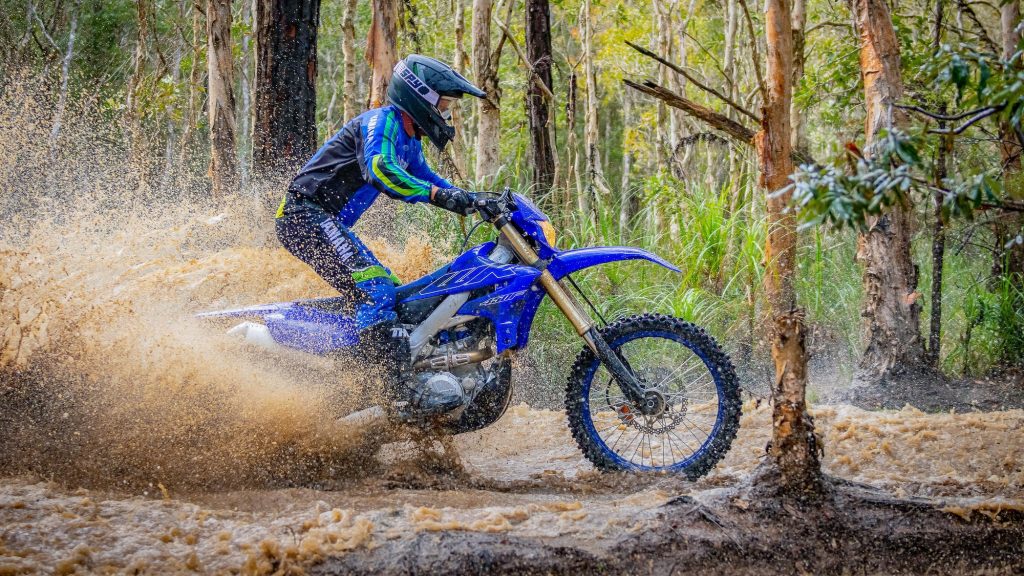
The 2020 Yamaha WR450F is an evolution of the previous model that’s similar to the YZ450F, but slightly more suited for the road.
The WR450F continues the spirit of the WR450F that it has had for over a decade — a high-performance, ultra-reliable single cylinder off-road bike that can also be taken on the highway (if you must).
It’s powered by a 450cc liquid-cooled four-stroke DOHC engine running a 13:1 compression ratio. It does have different intake/exhaust systems and a revised ECU compared to the YZ, softening it slightly. You can adjust tuning on the with Yamaha’s Power Tune app for different riding conditions.
Front and rear suspension is competent — fully adjustable, with an inverted fork up front, and ~30cm (12 inches) of travel front and rear. The wet weight is a paltry 120 kg (265 lb) making even the distance-oriented heavier WR450F a real lightweight.
You can use it to hit the trails with your friends in the bush or take it to competitions — the WR450F is a diversely capable bike.
While the YZ450F is a motocross bike built for racing, the WR450F has features that help it last the distance. These includ
- An engine guard
- An 18-inch rear wheel
- 2.2 gallon fuel tank
- Radiator fan (for when you go slow!)
- A sealed O-ring chain
- Fuel level and warning lights
- Steel rear sprocket
- Kickstand
- And of course, running gear in many markets (lights, mirrors etc.)
The Yamaha WR450F is built to compete with high-performance European endurance bikes like the Husqvarna FE 501 and its Japanese competitor (which came later to the party) the Honda CRF450L.
Reference — Screenshots from the Manual for the Yamaha WR450F
The above maintenance schedule came from the maintenance section in the WR450F’s manual.
Pictured below also is the competition maintenance schedule for the WR450F.
You can view it in Yamaha’s online manual repository here.
